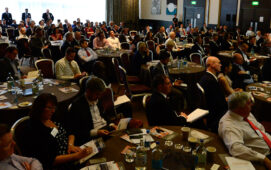
It’s been called the ESG elephant in the room, an environmental risk that’s been all too obvious but largely overlooked in the race to net-zero. But advances in ESG data modelling has sparked a gathering interest in biodiversity risk.
RepRisk and QuantCube are trialling new satellite-based solutions to collect data on the impacts of economic activity on the natural world. And asset managers from impact specialist Triodos Investment Management to global giants Aviva and Robeco are in talks with data partners to increase the flow of information on the topic.
Biodiversity describes the delicate balance of animals, plants and other organisms within nature. Disruption caused to one part of an ecosystem usually sets off a chain reaction of effects to other parts. Deforestation, for instance, often leads to soil loss and depletion of creatures that depend on the shelter and food provided by trees.
Financial institutions are getting to grips with biodiversity loss because they will soon be expected to report on the impacts of their activities and investments on nature. They are also beginning to factor those impacts into their portfolio risk models.
The topic received widespread recognition last year with the formation of the Taskforce on Nature-related Financial Disclosures. The organisation, created by an alliance of financial executives to improve risk reporting, is dedicated to shifting investment towards protecting ecosystems.
Attention on biodiversity is gaining momentum because data modellers are now able to attribute specific biodiversity loss events to particular activities, and companies, said Volker Lainer, Vice President for Product Management at data manager GoldenSource.
“With all the ESG data coming to light you have more concrete information on how specific companies contribute to biodiversity loss,” Lainer told ESG Insight. “We’ve always known that it was happening – that data has always been there. But we can now use that data in ways that helps us identify reasons for it happening – and attribute that to specific companies.”
Natural World
Attention has largely been focused on the impacts of deforestation, agriculture and mining. But there is a growing consensus that all manner of activities can have a profound impact on the natural world. For investors, this has meant paying closer attention to supply chains of companies in which they invest, especially those involved in manufacturing or primary industries.
Recognition of the topic has been slow to gain traction because of the complexity of interpreting the data in a way that is useful for reporting companies and investors.
“For corporates, assessing and managing across their supply chains where materials and inputs are sourced is … challenging,” wrote S&P Global in its 2022 ESG outlook report published this week. “Data availability and quality as well as generally agreed measurement methodologies remain key challenges. In addition, most of the corporate world still lacks commitments to stop deforestation despite being more easily measured than other natural capital risks, principally due to poor understanding of how to assess the benefits of preservation.”
Like S&P, Moody’s Investors Service expects improvements in biodiversity scoring and assessments to be a key feature of the ESG landscape this year.
“Investors and regulators will continue to push companies to identify, assess and disclose risks related to biodiversity and human impact on nature through their own operations as well as through their suppliers,” Moody’s wrote in its own preview of the year.
Vendors Respond
Much of the data used in biodiversity assessments is the same as that used in other environmental impact measurements. But data suppliers are increasingly finding ways to obtain more granular, nature-specific information.
Satellite data research company QuantCube, for instance, said last year it is developing tools to help track the impacts of human activity from space down to the level of individual animals.
“We able to measure the environmental impact of things like deforestation in terms of pollution and water pollution, directly without the need for proxy estimates,” QuantCube co-founder and Chief Executive Thanh-Long Huynh told ESG Insight. “There is more we can and will do with the data we get.”
The technology can be used to track individual tree species and animals, plotting their movements and changes to populations, Huynh said.
RepRisk is similarly creating a satellite-based solution to identify areas of environmental risk.
“Biodiversity is important as it supports life on earth and provides our societies with resilience and in ESG terms it underpins all of the other Sustainable Development Goals” outlined by the United Nations, Executive Vice President Alexandra Mihailescu Cichon told ESG Insight.
“The advantage of RepRisk’s data is that it provides daily-updated data and uses a rules-based methodology to identify and assess biodiversity risks – including a breadth of specific topic areas that can be used to better understand biodiversity risk exposure: for instance, monocultures, forest burning and coral reefs.”
Impact investment asset manager Triodos IM is working with its data partners to glean deeper insights into the biodiversity risks associated with its investments.
Triodos is seeking to set “particular standards that measure if a company could, if possible, have a positive impact on biodiversity,” Investment Strategist Roeland Tso told ESG Insight.
“We are trying to take the next step on biodiversity, trying to cooperate with like-minded investors to set a methodology that fits our strict criteria that ultimately would be transparent and comparable – and sustainable.”
Investors Worry
Growing understanding of the risks associated with biodiversity loss were underlined last week when life insurance giant Aviva said it would push boards to take more action on disruptions to the natural world.
In his annual letter to the leaders of 1,500 companies, Aviva Chief Executive Mark Versey called for executive bonuses to be linked to performance in lessening the impact of their activities and investments on nature.
“Simply cutting emissions but allowing the destruction of the rain forest to continue will do little to reverse global warming,” Versey wrote. “Companies need to adopt an integrated approach for maximum benefit.”
Dutch asset manager Robeco also published a position paper this week in which it announced a partnership with the World Wide Fund for Nature Netherlands to help it create a biodiversity-aware investment framework.
“It’s no longer just a question of avoiding those companies that are responsible for biodiversity loss through their environmentally damaging operations,” Robeco Climate Strategist Lucian Peppelenbos wrote. “We must also embrace those companies that are striving to protect biodiversity, directing more capital towards these sort of sustainable enterprises.”
Subscribe to our newsletter




